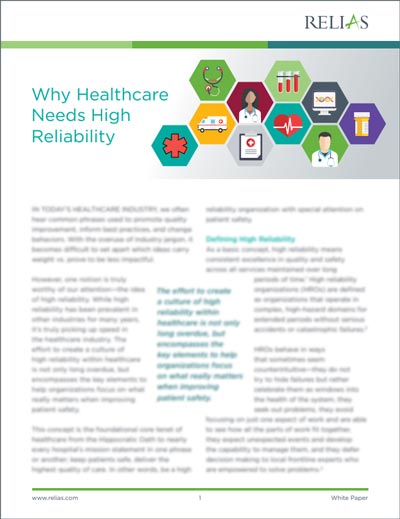As obstetrics (OB) claims continue to be prevalent across the nation, understanding the basic tenets of a high reliability unit (HRU) is paramount to affect positive change. In a sobering Medscape OB/GYN Malpractice 2017 Report, it was noted that an alarming 85% of OB/GYNs have been named in a lawsuit, with 62% having been sued between 2-5 different times.
Understanding that OB malpractice issues are rarely the result of a single act or omission by a single clinician, but rather involve a series of missteps and mishandled decisions by a team of physicians and nurses, led risk leaders at UHS of Delaware Inc. to prioritize the principles of high reliability into OB care improvement.
High Reliability in OB Care Story
During a uniquely styled and truly noteworthy webinar, UHS of Delaware Inc. risk leaders shed light on their system’s improvements to mitigate risk and improve patient safety for mothers and babies on their “journey down the yellow brick road to zero preventable harm in OB” presented as, “Are we in Oz Yet? One Health System’s Journey to High Reliability in OB Care.”
You can watch the webinar here.
The risk leaders openly shared significant insight on how their organization created, and more importantly, sustains an OB HRU. Attendees were able to take away specific clinical requirements and tactics for an OB HRU encompassing three areas: fetal assessment, labor management, and second stage labor care, as well as the necessary monitoring to ensure the placed strategies remain effective.
Following suit from the guidance and research by Mark R. Chassin and Jared M. Loeb, the risk leaders launched the high reliability journey by: assessing the organization’s maturity/ability to undertake HRU, mapping a starting point and a desired ending point, including milestones to mark progress along the way—all while understanding progress is made with incremental organizational changes and four key tools for improvement.
Four Tools for Improvement
1. HRU Meetings
Monthly corporate OB HRU meetings are held to provide guidance, followed by monthly facility OB HRU meetings. The latter are led/co-led by designated HRU physician champion(s) and attended by women’s services leadership, in addition to physicians and other labor and delivery team members. Main objectives of the meeting include: current ACOG, AWHONN, and AIM initiatives, policy and procedure review/revisions, case study reviews, and morbidity and mortality reviews.
2. Physician Champions
Designated OB HRU physician champions are held accountable for establishing and maintaining clear and respectful lines of communication with the OB department chair, OB providers (including physicians and midwives), the OB nursing director, and the unit manager as applicable. The physician champion is also responsible for collecting ongoing feedback from unit staff regarding HRU initiatives and encouraging participation and cooperation with HRU initiatives. By actively reviewing monthly stats and trends, the physician champion is the most appropriate advocate to lead the monthly OB HRU meetings and continually act as a model for best practices while serving as a liaison between the facility and corporate HRU medical director.
3. Emergency Drills
In an environment where adverse events and emergencies occur, time is of the essence and the best and strongest argument for preparation is a team working collaboratively on emergency drills. These multidisciplinary drills are held eight times per year (two per quarter), with at least one drill including “Stop the Line/CUS/Escalation” per year. The set drills and expectations include areas such as: emergency C-section, neonatal code, maternal code, delivery outside of labor and delivery, and failed maternal intubation/difficult intubation.
4. Relias OB Education Requirement
Chosen for its objective measures of both knowledge and judgement, Relias OB (formerly GNOSIS™) offers the most effective education solution, available for the full obstetrics team (both providers and nurses). To facilitate the system’s high reliability journey, Relias OB was a fundamental component of the labor and delivery team’s education and training.
Establishing a culture of high reliability
The system achieved impressive results in improving safety for their mothers and babies, and the team has worked to sustain those lessons learned and best practices. Through the implementation of OB Safety Huddle Boards, Monthly Meeting Newsletters, and Recognition Newsletters, UHS of Delaware Inc. has established a culture of high reliability where clear and routine communication and recognition of a job well done are truly valued.
While the journey to high reliability is always an ongoing one, the risk leaders at UHS of Delaware Inc. have developed a rewarding environment for their labor and delivery team, but more importantly for their patients. Perhaps no one understands more than a mother with a new baby the notion of “there’s no place like home,” always deserving of getting there safely and happily.
Relias—A National Leader in Maternal Safety
Relias offers the most effective education solution, available for the full obstetrics team (both providers and nurses) in both obstetrical hemorrhage and hypertensive disorders of pregnancy.
Relias OB (formerly GNOSIS™) is truly unique in its multidisciplinary education approach, ensuring that the entire labor and delivery team are following the same evidence-based best practices, allowing them to provide care and communicate as a true team.
How Relias Empowers High Reliability
At the end of the day, high reliability organizations are committed to being learning organizations. With a variety of solutions, Relias empowers organizations throughout every stage of the high reliability journey by identifying opportunities for improvement and providing clear results.

Why Healthcare Needs High Reliability
One notion is truly worthy of our attention and is only picking up speed in the healthcare industry—the idea of high reliability. Download this paper to learn more about high reliability’s history in the healthcare industry, characteristics of high reliability organizations, and challenges with adopting a culture of high reliability.
DOWNLOAD WHITE PAPER →





